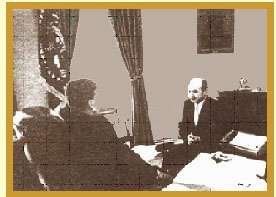16.3 The Institutions of Foreign Policy
The key issues of state are dealt with mainly by high-level foreign policy leaders. However, the day by day administration, the handling of routine problems, and the decisions that do not immediately involve great discretion are in the hands of institutions such as the Departments of State and Defense, the National Security Council (NSC), and the CIA. These institutions influence high level policies by gathering and evaluating data. The president, Congress, the Secretary of State and the people depend on these institutions for information, advice and for the execution of policy, after it has been determined.
16.3a Department of State
The Department of State is the key agency of the executive branch, dealing with foreign affairs. It furnishes the president with the information he requires in conducting international relations. It helps the president to form and implement policy. It is primarily responsible for representing the U.S. in its dealings with other nations and international organizations with which it carries on negotiations. It also coordinates the activities of all the groups, agencies and interdepartmental committees participating in the formulation and execution of foreign policy.

Exhibit 16.3
John F. Kennedy meets with the Secretary of State
The Secretary of State is the head of the Department of State and acts as the chief negotiator and representative of the U.S. abroad. He serves as the chief foreign policy adviser to the president, and acts as chief spokesman for the administration on foreign policy.
The American Foreign Service is an important part of the State
Department. It carries out foreign policy as expressed in the directives
of the Secretary of State, gathers data for American policymakers,
protects Americans and American interests in foreign countries,
and cultivates friendly relations with foreign peoples. American
embassies and consulates around the world are staffed by the Foreign
Service. Ambassadors, ministers, officers, reserve officers, and
staff comprise the American Foreign Service.
16.3b Department of Defense
The National Security Act of 1947 created a Department of Defense, in order to supervise and coordinate all military activities. The military departments, namely Army, Navy and Air Force, were included as statutory agencies. The Defense Department was designed for the establishment of integrated policies and procedures for the three military departments, though each of them was separately organized under its own secretary. The Department of Defense also includes the Joint Chiefs of Staff, the unified and specified commands, and a group of Defense Staff Officers.
The Secretary of Defense, who is also a member of the Presidentís Cabinet, is the Presidentís principal assistant on defense matters. Under the commander-in-chief, he is in charge of the military power of the U.S. Robert McNamara, the secretary of defense, under Presidents Kennedy and Johnson led to great changes in the operation of the Department of Defense. Secretary McNamara, brought to the Department a small group of men, trained mainly as economists and analysts. Along with his "whiz kids" as they were called, Secretary McNamara coordinated the supply and intelligence activities of the services, created unified military commands and brought greater unification of the department.
The major task of the Joint Chief of Staff is to formulate strategic war plans. It is made up of the top military leaders in the Army, Navy, and Air Force, as well as a chairman designated by the president.
16.3c National Security Council
In 1947 Congress created the National Security Council to help the President in the integration of foreign, military, economic, fiscal, internal security, and psychological policies affecting American national security. It is composed of the Vice President, Secretary of State, Secretary of Defense, Director of the Office of Emergency Planning and such other officers as the president shall appoint to it. The meetings of the council are attended by the chairman of the Joint Chiefs of Staff, as well as by the Director of the CIA. The Special Assistant to the president for National Security Affairs acts as the Executive Secretary for the council staff. The members of the council are expected to serve not only as representatives of their departments "but as a collegiate body seeking over-all policies rather than compromises of agenciesí positions."
President Eisenhower relied heavily on the National Security Council. However, President Kennedy coordinated security policies through his own Special Assistant for National Security Affairs, along with a small personal staff, and relied less on the NSC. However the NSC remains an important channel through which broad issues of national security are brought forward for presidential decision.
16.3d Central Intelligence Agency
Of the many agencies engaged in intelligence work, the Central Intelligence Agency (CIA) is the most important. The CIA not only correlates and evaluates information gathered by other agencies, but also collects intelligence through its own agents located all over the world. Further, it prepares the National Intelligence Surveys, which provide encyclopedic compendia for most of the countries of the world. These surveys provide the American policymakers with the combined judgments of the intelligence agencies on a wide range of topics, as for example Chinese Communist Policy in Asia in light of the Sino-Soviet Split.
Over the years, the CIA, which operates in secrecy, has become an instrument to make implement policies. It has engineered the overthrow of governments in Iran, Laos and Guatemala. It was in charge of the ill-fated attempt to invade Castroís Cuba. However as Roger writes, "The real problem of CIA, the inherent tension in conducting secret intelligence in a free society, remains".
[next page]
|
Index
16.0 -
Introduction
16.1 -
Background Of American Foreign Policy
16.2 -
Making Foreign Policy
16.3 -
The Institutions Of Foreign Policy
16.4 -
Issues In Foreign Policy
Chapter
1
|